
Zamosc Fortress
Encyclopedia
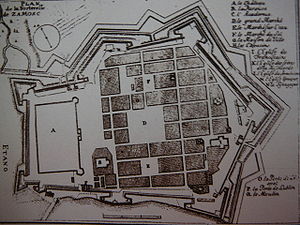
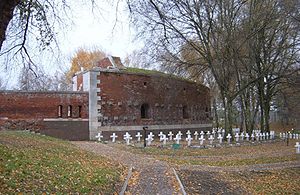
Zamosc
Zamość ukr. Замостя is a town in southeastern Poland with 66,633 inhabitants , situated in the south-western part of Lublin Voivodeship , about from Lublin, from Warsaw and from the border with Ukraine...
(southeastern Poland). It was built between 1579 and 1618, and the construction was initiated by Chancellor and Hetman Jan Zamoyski
Jan Zamoyski
Jan Zamoyski , was a Polish-Lithuanian nobleman, magnate, 1st duke/ordynat of Zamość. Royal Secretary since 1566, Lesser Kanclerz ) of the Crown since 1576, Lord Grand-Chancellor of the Crown since 1578, and Grand Hetman of the Crown since 1581...
. It was one of the biggest fortresses of the Polish-Lithuanian Commonwealth
Polish-Lithuanian Commonwealth
The Polish–Lithuanian Commonwealth was a dualistic state of Poland and Lithuania ruled by a common monarch. It was the largest and one of the most populous countries of 16th- and 17th‑century Europe with some and a multi-ethnic population of 11 million at its peak in the early 17th century...
, built so solidly that it was able to resist the attacks of both the Cossack
Cossack
Cossacks are a group of predominantly East Slavic people who originally were members of democratic, semi-military communities in what is today Ukraine and Southern Russia inhabiting sparsely populated areas and islands in the lower Dnieper and Don basins and who played an important role in the...
s and the Swedes
Sweden
Sweden , officially the Kingdom of Sweden , is a Nordic country on the Scandinavian Peninsula in Northern Europe. Sweden borders with Norway and Finland and is connected to Denmark by a bridge-tunnel across the Öresund....
during the Deluge. It was taken down in 1866, although fragments survive.
Altogether, the fortress went through six sieges, with the first one taking place in 1648, during the Khmelnytsky Uprising
Khmelnytsky Uprising
The Khmelnytsky Uprising, was a Cossack rebellion in the Ukraine between the years 1648–1657 which turned into a Ukrainian war of liberation from Poland...
. Eight years later it was surrounded by the Swedes, who came there again in 1703, then, in 1809, by the army of the Duchy of Warsaw
Duchy of Warsaw
The Duchy of Warsaw was a Polish state established by Napoleon I in 1807 from the Polish lands ceded by the Kingdom of Prussia under the terms of the Treaties of Tilsit. The duchy was held in personal union by one of Napoleon's allies, King Frederick Augustus I of Saxony...
, which captured it from the Austrians. The longest one was the siege of Zamość of 1813, when the Polish garrison for 8 months defended the fortress from the Russians
Russians
The Russian people are an East Slavic ethnic group native to Russia, speaking the Russian language and primarily living in Russia and neighboring countries....
. The last siege took place during the November Uprising
November Uprising
The November Uprising , Polish–Russian War 1830–31 also known as the Cadet Revolution, was an armed rebellion in the heartland of partitioned Poland against the Russian Empire. The uprising began on 29 November 1830 in Warsaw when the young Polish officers from the local Army of the Congress...
, when Zamość was the last point of Polish defence which fell to the Russians. The fortress, which had in the meantime become obsolete, was closed down in 1866.
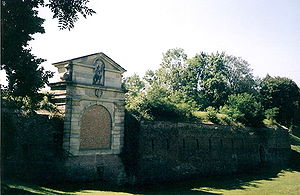
Construction and later changes
Zamość fortress, as well as the town of Zamość, are the brainchild of Chancellor Jan ZamoyskiJan Zamoyski
Jan Zamoyski , was a Polish-Lithuanian nobleman, magnate, 1st duke/ordynat of Zamość. Royal Secretary since 1566, Lesser Kanclerz ) of the Crown since 1576, Lord Grand-Chancellor of the Crown since 1578, and Grand Hetman of the Crown since 1581...
, who in the second half of the 16th century decided to found a new, private city in the middle of nowhere, named after himself. The foundation charter was issued on April 3, 1580, and the first name of the town was Zamośćie by the Wieprzec river.
Both fortifications and the city were planned by Italian architect from Padua
Padua
Padua is a city and comune in the Veneto, northern Italy. It is the capital of the province of Padua and the economic and communications hub of the area. Padua's population is 212,500 . The city is sometimes included, with Venice and Treviso, in the Padua-Treviso-Venice Metropolitan Area, having...
, Bernardo Morando
Bernardo Morando
Bernardo Morando, also known as Bernardino or Morandi was a Polish-Italian architect. He is notable as the author of a new town of Zamość, modelled on Renaissance theories of the 'ideal city'....
. He decided to take advantage of the two local rivers — Topornica
Topornica
Topornica is a village in the administrative district of Gmina Zamość, within Zamość County, Lublin Voivodeship, in eastern Poland. It lies approximately south-west of Zamość and south-east of the regional capital Lublin.-References:...
and Labunka, whose waters were used to fill the moat.
The first castle was built in 1579, and in the following years additional buildings were added — the Arsenal
Arsenal
An arsenal is a place where arms and ammunition are made, maintained and repaired, stored, issued to authorized users, or any combination of those...
(1582), Lublin
Lublin
Lublin is the ninth largest city in Poland. It is the capital of Lublin Voivodeship with a population of 350,392 . Lublin is also the largest Polish city east of the Vistula river...
Gate (1588), Lwów Gate (1599) and Szczebrzeszyn
Szczebrzeszyn
Szczebrzeszyn is a city in southeastern Poland in Lublin Voivodeship, in Zamość County, about 20 km west of Zamość. From 1975–1999, it was part of the Zamość Voivodeship administrative district. The town serves as the seat to Gmina Szczebrzeszyn. A 2004 census counted 5,357 inhabitants...
Gate, completed in 1603 by Blaise Gocman, each one with a drawbridge. The entire complex was not finished until 1620, by another Italian architect, Andrea dell'Aqua, who was helped by Jan Wolff and Jan Jaroszowic. The fortress was shaped as a septangle, with seven bastions, located around 200 meters from each other, as this was the range of the 17th century artillery. The fortress, with its impressive brickwork, 12 m high and 2.5 m thick, was one of the most modern and largest strongholds of the Polish-Lithuanian Commonwealth
Polish-Lithuanian Commonwealth
The Polish–Lithuanian Commonwealth was a dualistic state of Poland and Lithuania ruled by a common monarch. It was the largest and one of the most populous countries of 16th- and 17th‑century Europe with some and a multi-ethnic population of 11 million at its peak in the early 17th century...
, together with Kamieniec Podolski.
In 1683, architect Jan Michal Link began modernization of the fortress, which lasted until 1694. Walls were strengthened, and two smaller bastions were replaced by a large one. After these works, the fortress was not repaired until 1809, when government of the Duchy of Warsaw
Duchy of Warsaw
The Duchy of Warsaw was a Polish state established by Napoleon I in 1807 from the Polish lands ceded by the Kingdom of Prussia under the terms of the Treaties of Tilsit. The duchy was held in personal union by one of Napoleon's allies, King Frederick Augustus I of Saxony...
invested heavily into several changes. New gates were placed, two older gates were bricked up, bastions were enlarged. However, the works were not completed because of the French invasion of Russia
French invasion of Russia
The French invasion of Russia of 1812 was a turning point in the Napoleonic Wars. It reduced the French and allied invasion forces to a tiny fraction of their initial strength and triggered a major shift in European politics as it dramatically weakened French hegemony in Europe...
.
Further improvements were continued by the government of the Congress Poland
Congress Poland
The Kingdom of Poland , informally known as Congress Poland , created in 1815 by the Congress of Vienna, was a personal union of the Russian parcel of Poland with the Russian Empire...
, which in 1820 bought the city from ordynat Stanislaw Kostka Zamoyski. All buildings within 1200 meters from the walls were destroyed, and within the radius of 2400 meters, only wooden structures were permitted. A Blockhaus was constructed as well as extensive entrenchments. Buildings in the town were remodelled so that they would serve the military. They were stripped of Baroque decorations and rebuilt in the neoclassicistic style.
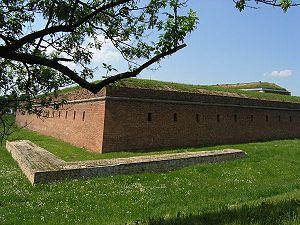
First siege
In November 1648, during the Khmelnytsky UprisingKhmelnytsky Uprising
The Khmelnytsky Uprising, was a Cossack rebellion in the Ukraine between the years 1648–1657 which turned into a Ukrainian war of liberation from Poland...
, Zamość was surrounded by joint Cossack
Cossack
Cossacks are a group of predominantly East Slavic people who originally were members of democratic, semi-military communities in what is today Ukraine and Southern Russia inhabiting sparsely populated areas and islands in the lower Dnieper and Don basins and who played an important role in the...
— Tatar forces under command of Bohdan Khmelnytsky
Bohdan Khmelnytsky
Bohdan Zynoviy Mykhailovych Khmelnytsky was a hetman of the Zaporozhian Cossack Hetmanate of Polish–Lithuanian Commonwealth . He led an uprising against the Commonwealth and its magnates which resulted in the creation of a Cossack state...
and Tugay Bey. The fortress was defended by approximately 4700 soldiers under castellan of Elbląg
Elblag
Elbląg is a city in northern Poland with 127,892 inhabitants . It is the capital of Elbląg County and has been assigned to the Warmian-Masurian Voivodeship since 1999. Before then it was the capital of Elbląg Voivodeship and a county seat in Gdańsk Voivodeship...
Ludwik Weyher and Wladyslaw Myszkowski. Also, within city walls, there were numerous refugees from lands of Red Ruthenia
Red Ruthenia
Red Ruthenia is the name used since medieval times to refer to the area known as Eastern Galicia prior to World War I; first mentioned in Polish historic chronicles in the 1321, as Ruthenia Rubra or Ruthenian Voivodeship .Ethnographers explain that the term was applied from the...
, Podolia
Podolia
The region of Podolia is an historical region in the west-central and south-west portions of present-day Ukraine, corresponding to Khmelnytskyi Oblast and Vinnytsia Oblast. Northern Transnistria, in Moldova, is also a part of Podolia...
and Volhynia
Volhynia
Volhynia, Volynia, or Volyn is a historic region in western Ukraine located between the rivers Prypiat and Southern Bug River, to the north of Galicia and Podolia; the region is named for the former city of Volyn or Velyn, said to have been located on the Southern Bug River, whose name may come...
.
On November 5, the enemy burned nearby villages, but the fortress itself was untouched. Soon afterwards, Cossack engineers managed to remove water from southern mound, exposing the wall in that area. However, Khmelnytski's forces were inadequate, and winter was approaching. Since the defenders were also aware of their difficult situation, both sides signed a truce. For the price of 20 000 talar
Talar
Talar is the architectural term given to the throne of the Persian monarchs which is carved on the rock-cut tomb of Darius at Naqsh-e Rostam, near Persepolis, and above the portico which was copied from his palace....
s, the Cossack-Tatar forces decided to end the siege and returned home for the winter.
Second siege
In the summer of 1655, the joint Russo-Cossack forces approached near the fortress, but they did not try to capture it. Instead, when late that year Jan II Zamoyski decided to support King John II Casimir of PolandJohn II Casimir of Poland
John II Casimir was King of Poland and Grand Duke of Lithuania during the era of the Polish–Lithuanian Commonwealth, Duke of Opole in Upper Silesia, and titular King of Sweden 1648–1660. In Poland, he is known and commonly referred as Jan Kazimierz. His parents were Sigismund III Vasa and...
, Zamość was besieged by the Swedes (see: The Deluge (Polish history)
The Deluge (Polish history)
The term Deluge denotes a series of mid-17th century campaigns in the Polish–Lithuanian Commonwealth. In a wider sense it applies to the period between the Khmelnytsky Uprising of 1648 and the Truce of Andrusovo in 1667, thus comprising the Polish–Lithuanian theaters of the Russo-Polish and...
), whose troops appeared at the gates of the stronghold on February 25, 1656. After a few days, King Charles X Gustav
Charles X Gustav of Sweden
Charles X Gustav also Carl Gustav, was King of Sweden from 1654 until his death. He was the son of John Casimir, Count Palatine of Zweibrücken-Kleeburg and Catherine of Sweden. After his father's death he also succeeded him as Pfalzgraf. He was married to Hedwig Eleonora of Holstein-Gottorp, who...
joined the forces.
The Swedes began with artillery barrage, but due to lack of heavy guns, it was not successful. Within a few days, Charles X Gustav realized that capturing Zamość, whose fortifications had been strengthened since 1648, was impossible, and on March 1, the invaders withdrew. Swedish siege of Zamość was later described by Henryk Sienkiewicz
Henryk Sienkiewicz
Henryk Adam Aleksander Pius Sienkiewicz was a Polish journalist and Nobel Prize-winning novelist. A Polish szlachcic of the Oszyk coat of arms, he was one of the most popular Polish writers at the turn of the 19th and 20th centuries, and received the Nobel Prize in Literature in 1905 for his...
, in his popular book The Deluge (novel). Next year, the Transilvanian army under George II Rákóczi
George II Rákóczi
György Rákóczi II , a Transylvanian Hungarian ruler, was the eldest son of George I and Susanna Lorantffy....
appeared near Zamość, but it did not even try to capture the mighty fortress. According to a legend, when Swedish representatives came to the town and proposed the capitulation of the fortress, Jan ‘Sobiepan’ Zamoyski answered: "I am the Lord for myself and I will not give Zamość to the Swedes".
In the last stage of the war, Zamość was a prison for high ranking officers of the Swedish Army
Swedish Army
The Swedish Army is one of the oldest standing armies in the world and a branch of the Swedish Armed Forces; it is in charge of land operations. General Sverker Göranson is the Supreme Commander-in-Chief of the Army.- Organization :...
. Among those kept there, was Field Marshal
Field Marshal
Field Marshal is a military rank. Traditionally, it is the highest military rank in an army.-Etymology:The origin of the rank of field marshal dates to the early Middle Ages, originally meaning the keeper of the king's horses , from the time of the early Frankish kings.-Usage and hierarchical...
Arvid Wittenberg
Arvid Wittenberg
Arvid Wittenberg or Arvid Wirtenberg von Debern , Swedish count, field marshal and privy councillor. Born in Porvoo, Finland, died in prison in Zamość, Poland, 7 September 1657...
, who died in prison of natural causes.
Third siege
Late 17th century marked the decline of the Commonwealth, a decline reflected in the general state of repair of the fortress. The Great Northern WarGreat Northern War
The Great Northern War was a conflict in which a coalition led by the Tsardom of Russia successfully contested the supremacy of the Swedish Empire in northern Central Europe and Eastern Europe. The initial leaders of the anti-Swedish alliance were Peter I the Great of Russia, Frederick IV of...
did not spare Zamość, as on February 11, 1703, Swedish units under General Magnus Stenbock
Magnus Stenbock
Count Magnus Gustafsson Stenbock was a Swedish military officer at the time of the Great Northern War.He was the son of Gustaf Otto Stenbock and Christina Catharine de la Gardie....
approached the stronghold and besieged it. However, after a week, the Swedes withdrew, to return next year with additional troops. Polish defenders, counted at only 260, were unable to resist the attackers and quickly surrendered. Swedish occupation was short and in 1705, Russian soldiers, with permission of Ordynat Tomasz Jozef Zamoyski
Tomasz Józef Zamoyski
Tomasz Józef Zamoyski was a Polish nobleman .Tomasz became the 5th Ordynat of Zamość estate. He was also starost of Płoskirów and Gródek and became a Royal Colonel....
, entered Zamość. The 1000 Russian garrison remained there until May 1706.
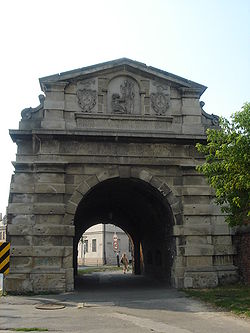
Fourth siege
After the Partitions of PolandPartitions of Poland
The Partitions of Poland or Partitions of the Polish–Lithuanian Commonwealth took place in the second half of the 18th century and ended the existence of the Polish–Lithuanian Commonwealth, resulting in the elimination of sovereign Poland for 123 years...
, Zamość became part of the Austrian Empire
Austrian Empire
The Austrian Empire was a modern era successor empire, which was centered on what is today's Austria and which officially lasted from 1804 to 1867. It was followed by the Empire of Austria-Hungary, whose proclamation was a diplomatic move that elevated Hungary's status within the Austrian Empire...
, to which it belonged until 1809. During Napoleonic Wars
Napoleonic Wars
The Napoleonic Wars were a series of wars declared against Napoleon's French Empire by opposing coalitions that ran from 1803 to 1815. As a continuation of the wars sparked by the French Revolution of 1789, they revolutionised European armies and played out on an unprecedented scale, mainly due to...
, units of the Duchy of Warsaw
Duchy of Warsaw
The Duchy of Warsaw was a Polish state established by Napoleon I in 1807 from the Polish lands ceded by the Kingdom of Prussia under the terms of the Treaties of Tilsit. The duchy was held in personal union by one of Napoleon's allies, King Frederick Augustus I of Saxony...
, under Prince Jozef Poniatowski, besieged Zamość and managed to capture it. The siege began on May 15, 1809, when units under General Ignacy Kamienski approached the fortress, whose garrison consisted of 3000 soldiers, commanded by Colonel Ferdinand von Pulszky. Two days later, Polish forces were strengthened by additional units under French general Jean Pelletier, who served in the Polish Army. Joined Polish-French forces were aided by local population, also several Austrian recruits were Polish, and during the attack, these soldiers did not engage themselves in the fighting. The attack took place in the night of May 19/20, 1809, from 2 to 4 a.m. The main impact was directed on the Lublin Gate, which surprised the Austrians, as they had been expecting the attack on the weakest, southern wall. The fortress was captured after a few hours. Interestingly enough, one of participants of the siege, Joanna Zubrowa, became the first woman to receive the Virtuti Militari
Virtuti Militari
The Order Wojenny Virtuti Militari is Poland's highest military decoration for heroism and courage in the face of the enemy at war...
.

Fifth siege
After Napoleon's failed invasion on Russia (1812), the fortress was besieged by the Russian forces, which approached Zamość in February 1813. Polish defenders, under General Maurycy Hauke were well-prepared, with 4000 soldiers, 130 cannons and food supplies for four months. The Russians were commanded by General Rath, and their number is estimated at up to 17 000 (as for August 1813), with 160 cannons. After a few weeks of the siege, epidemic of scurvyScurvy
Scurvy is a disease resulting from a deficiency of vitamin C, which is required for the synthesis of collagen in humans. The chemical name for vitamin C, ascorbic acid, is derived from the Latin name of scurvy, scorbutus, which also provides the adjective scorbutic...
broke out in the fortress. However, this was managed and the Polish defence of Zamość continued for several months. In mid-June, both sides signed a temporary truce and the Russians limited their summer actions to blocking the fortress. Months of siege depleted the resources and supplies of the defenders. In October 1813, some 1200 soldiers were sick and almost all were starving. All horses, dogs and cats were eaten, within one month, 450 persons died. On October 22, news of Napoleon's defeat in the Battle of Leipzig
Battle of Leipzig
The Battle of Leipzig or Battle of the Nations, on 16–19 October 1813, was fought by the coalition armies of Russia, Prussia, Austria and Sweden against the French army of Napoleon. Napoleon's army also contained Polish and Italian troops as well as Germans from the Confederation of the Rhine...
reached Zamość, and it lowered the spirits of the Poles. The decision to capitulate was taken on November 19, after eight months of siege. Out of 4000 defenders, 1500 died, mostly of disease and hunger. The fortress became part of Congress Poland
Congress Poland
The Kingdom of Poland , informally known as Congress Poland , created in 1815 by the Congress of Vienna, was a personal union of the Russian parcel of Poland with the Russian Empire...
.
Sixth siege
During the November UprisingNovember Uprising
The November Uprising , Polish–Russian War 1830–31 also known as the Cadet Revolution, was an armed rebellion in the heartland of partitioned Poland against the Russian Empire. The uprising began on 29 November 1830 in Warsaw when the young Polish officers from the local Army of the Congress...
, the fortress was one of main centers of Polish resistance. Commanded by Julian Sierawski and later Jan Krysinski, its garrison consisted of 3800 soldiers. Zamość was a base of Polish units operating in the area of Lublin
Lublin
Lublin is the ninth largest city in Poland. It is the capital of Lublin Voivodeship with a population of 350,392 . Lublin is also the largest Polish city east of the Vistula river...
, however, after Polish defeat in the Battle of Ostrołęka, the Russians took the initiative. The blockade of Zamość began in July 1831, and the fortress itself capitulated on November 21, as the last resistance point of the country.
Liquidation of the fortress and modern times
After the November Uprising, the fortress declined. Technological advance in warfare was decisive and finally, tsar Alexander II of RussiaAlexander II of Russia
Alexander II , also known as Alexander the Liberator was the Emperor of the Russian Empire from 3 March 1855 until his assassination in 1881...
officially closed the stronghold in 1866. In the following years, large parts of fortifications were demolished.
In 1992, Zamość, which is one of the classical monuments of Renaissance urban layout in Europe, was included on the list of the World's Cultural Heritage by UNESCO.
Further reading
- Zamość. Z przeszlosi twierdzy i miasta, red. A. Koprukowniak i A. Witusik, Lublin 1980, ISBN 83-222-0046-3
- J. Nadzieja, Zamość 1813, Warszawa 1994, ISBN 83-11-08203-0
- W. Sladkowski, Zamość pod znakiem Marsa [w:] Czterysta lat Zamośćia, red. J. Kowalczyk, Ossolineum 1983, ISBN 83-04-01284-7
- Stanislaw Lagowski: Szlakiem twierdz i ufortyfikowanych przedmosci. Pruszków: Oficyna Wydawnicza Ajaks, 2005, ss. 15–31. ISBN 83-88773-96-8.
- Stanislaw Herbst, Zachwatowicz Jan: Twierdza Zamość. Warszawa: 1936.
- St. Herbst, Zamość, Warszawa 1954
External links
Lublin Voivodeship°N date=December 2010°W

